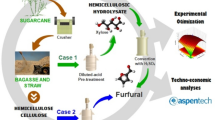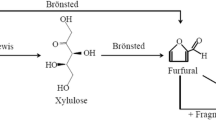Abstract
5-Hydroxymethylfurfural (HMF) production from fructose was studied by using niobium phosphate as solid acid catalyst. HMF selectivity was optimized in a water-acetone system and compared to a water system. The HMF optimal selectivity for process carried out in the water-acetone system was 62.94%. When the process was performed in water, the HMF selectivity achieved 55.73%. These results were used in a large-scale simulation and economic analysis of the two processes. The higher selectivity of system water-acetone affected the HMF minimum selling price (MSP). The MSP value was 2.21 USD/kg for process performed in water-acetone and 3.05 USD/kg for process in water. In the sensitivity analysis, we have found that in addition to process selectivity, the fructose cost was the most significant factor affecting HMF price.









Similar content being viewed by others
References
Van Putten RJ, Van Der Waal JC, De Jong E, Rasrendra CB, Heeres HJ, De Vries JG (2013) Hydroxymethylfurfural, a versatile platform chemical made from renewable resources. Chem Rev 113:1499–1597. https://doi.org/10.1021/cr300182k
Torres AI, Daoutidis P, Tsapatsis M (2010) Continuous production of 5-hydroxymethylfurfural from fructose: a design case study. Energy Environ Sci 3:1560. https://doi.org/10.1039/c0ee00082e
Avantium (2015) Bio-based plastic as a key industry issue. https://www.avantium.com/press-releases/bio-based-plastic-as-a-key-industry-issue/. Accessed 31 Oct 2015
Chheda JN, Roman-Leshkov Y, Dumesic JA (2007) Production of 5-hydroxymethylfurfural and furfural by dehydration of biomass-derived mono- and poly-saccharides. Green Chem 9:342–350. https://doi.org/10.1039/b611568c
Rosatella AA, Simeonov SP, Frade RFM, Afonso CAM (2011) 5-Hydroxymethylfurfural (HMF) as a building block platform: biological properties, synthesis and synthetic applications. Green Chem 13:754. https://doi.org/10.1039/c0gc00401d
Tong X, Ma Y, Li Y (2010) Biomass into chemicals: conversion of sugars to furan derivatives by catalytic processes. Appl Catal A Gen 385:1–13. https://doi.org/10.1016/j.apcata.2010.06.049
Carlini C, Patrono P, Galletti AMR, Sbrana Glauco G (2004) Heterogeneous catalysts based on vanadyl phosphate for fructose dehydration to 5-hydroxymethyl-2-furaldehyde. Appl Catal A Gen 275:111–118. https://doi.org/10.1016/j.apcata.2004.07.026
Zhang Y, Wang J, Li X, Liu X, Xia Y, Hu B, Lu G, Wang Y (2015) Direct conversion of biomass-derived carbohydrates to 5-hydroxymethylfurural over water-tolerant niobium-based catalysts. Fuel 139:301–307. https://doi.org/10.1016/j.fuel.2014.08.047
Chareonlimkun A, Champreda V, Shotipruk A, Laosiripojana N (2010) Catalytic conversion of sugarcane bagasse, rice husk and corncob in the presence of TiO2, ZrO2 and mixed-oxide TiO2-ZrO2 under hot compressed water (HCW) condition. Bioresour Technol 101:4179–4186. https://doi.org/10.1016/j.biortech.2010.01.037
Yemiş O, Mazza G (2012) Optimization of furfural and 5-hydroxymethylfurfural production from wheat straw by a microwave-assisted process. Bioresour Technol 109:215–223. https://doi.org/10.1016/j.biortech.2012.01.031
Kuster BFM (1990) 5-Hydroxymethylfurfural (HMF). A review focussing on its manufacture. Starch - Stärke 42:314–321. https://doi.org/10.1002/star.19900420808
Sanborn AJ (2009) Processes for the preparation and purification of hydroxymethylfuraldehyde and derivatives. US Patent 7579489B2
Qi X, Watanabe M, Aida TM, Smith RL Jr (2008) Catalytic dehydration of fructose into 5-hydroxymethylfurfural by ion-exchange resin in mixed-aqueous system by microwave heating. Green Chem 10:799. https://doi.org/10.1039/b801641k
Kuster BFM, Van Der Baan HVS (1977) The influence of the initial and catalyst concentrations on the dehydration of d-fructose. Carbohydr Res 54:165–176. https://doi.org/10.1016/S0008-6215(00)84806-5
Bicker M, Hirth J, Vogel H (2003) Dehydration of fructose to 5-hydroxymethylfurfural in sub- and supercritical acetone. Green Chem 5:280–284. https://doi.org/10.1039/b211468b
Mukherjee A, Dumont M-J, Raghavan V (2015) Review: sustainable production of hydroxymethylfurfural and levulinic acid: challenges and opportunities. Biomass Bioenergy 72:143–183. https://doi.org/10.1016/j.biombioe.2014.11.007
Takeuchi Y, Jin F, Tohji K, Enomoto H (2008) Acid catalytic hydrothermal conversion of carbohydrate biomass into useful substances. J Mater Sci 43:2472–2475. https://doi.org/10.1007/s10853-007-2021-z
Carniti P, Gervasini A, Biella S, Auroux A (2006) Niobic acid and niobium phosphate as highly acidic viable catalysts in aqueous medium: fructose dehydration reaction. Catal Today 118:373–378. https://doi.org/10.1016/j.cattod.2006.07.024
Armaroli T, Busca G, Carlini C, Giuttari M, Raspolli Galletti AM, Sbrana G (2000) Acid sites characterization of niobium phosphate catalysts and their activity in fructose dehydration to 5-hydroxymethyl-2-furaldehyde. J Mol Catal A Chem 151:233–243. https://doi.org/10.1016/S1381-1169(99)00248-4
Carlini C, Giuttari M, Maria Raspolli Galletti A, Sbrana G, Armaroli T, Busca G (1999) Selective saccharides dehydration to 5-hydroxymethyl-2-furaldehyde by heterogeneous niobium catalysts. Appl Catal A Gen 183:295–302. https://doi.org/10.1016/S0926-860X(99)00064-2
Yang F, Liu Q, Bai X, Du Y (2011) Conversion of biomass into 5-hydroxymethylfurfural using solid acid catalyst. Bioresour Technol 102:3424–3429. https://doi.org/10.1016/j.biortech.2010.10.023
Moreau C, Durand R, Razigade S, Duhamet J, Faugeras P, Rivalier P, Ros P, Avignon G (1996) Dehydration of fructose to 5-hydroxymethylfurfural over H-mordenites. Appl Catal A Gen 145:211–224. https://doi.org/10.1016/0926-860X(96)00136-6
Ordomsky VV, Sushkevich VL, Schouten JC, van der Schaaf J, Nijhuis TA (2013) Glucose dehydration to 5-hydroxymethylfurfural over phosphate catalysts. J Catal 300(2013):37–46. https://doi.org/10.1016/j.jcat.2012.12.028
Catrinck MN, Ribeiro ES, Monteiro RS, Ribas RM, Barbosa MHP, Teófilo RF (2017) Direct conversion of glucose to 5-hydroxymethylfurfural using a mixture of niobic acid and niobium phosphate as a solid acid catalyst. Fuel 210:67–74. https://doi.org/10.1016/j.fuel.2017.08.035
Abrams DS, Prausnitz JM (1975) Statistical thermodynamics of liquid mixtures: a new expression for the excess Gibbs energy of partly or completely miscible systems. AICHE J 21:116–128. https://doi.org/10.1002/aic.690210115
Kazi FK, Patel AD, Serrano-Ruiz JC, Dumesic JA, Anex RP (2011) Techno-economic analysis of dimethylfuran (DMF) and hydroxymethylfurfural (HMF) production from pure fructose in catalytic processes. Chem Eng J 169:329–338. https://doi.org/10.1016/j.cej.2011.03.018
Rodrigues FA, Guirardello R (2012) Techno-economic evaluation of large scale 2.5-dimethylfuran production from fructose. In: Dr. Zeeshan Nawaz, Prof. Dro. Shahid Naveed. (Org.). Advances in chemical engineering. Croácia: SABIC Technical & Innovation, Saudi ;Basic Industries Corporation, Riyadh, pp 435–448
ICIS (2016). http://www.icis.com. Accessed 27 Apr 2016
Triebl C, Nikolakis V, Ierapetritou M (2013) Simulation and economic analysis of 5-hydroxymethylfurfural conversion to 2,5-furandicarboxylic acid. Comput Chem Eng 52:26–34. https://doi.org/10.1016/j.compchemeng.2012.12.005
Choudhary V, Mushrif SH, Ho C, Anderko A, Nikolakis V, Marinkovic NS, Frenkel AI, Sandler SI, Vlachos DG (2013) Insights into the interplay of Lewis and Bronsted acid catalysts in glucose and fructose conversion to 5-(hydroxymethyl)furfural and levulinic acid in aqueous media. J Am Chem Soc 135:3997–4006. https://doi.org/10.1021/ja3122763
Qi X, Watanabe M, Aida TM, Smith RLJ (2008) Selective conversion of D-fructose to 5-hydroxymethylfurfural by ion-exchange resin in acetone/dimethyl sulfoxide solvent mixtures. Ind Eng Chem Res 47:9234–9239. https://doi.org/10.1021/ie801016s
Qi X, Watanabe M, TML A, Smith R Jr (2009) Sulfated zirconia as a solid acid catalyst for the dehydration of fructose to 5- hydroxymethylfurfural. Catal Commun 10:1771. https://doi.org/10.1016/j.catcom.2008.04.025
Roman-Leshkov Y, Chheda JN, Dumesic JA (2006) Phase modifiers promote efficient production of hydroxymethylfurfural from fructose. Science 312:1933–1937. https://doi.org/10.1126/science.1126337
Bicker M, Kaiser D, Ott L, Vogel H (2005) Dehydration of D-fructose to hydroxymethylfurfural in sub- and supercritical fluids. J Supercrit Fluids 36:118–126. https://doi.org/10.1016/j.supflu.2005.04.004
Gomes FNDC, Pereira LR, Ribeiro NFP, Souza MMVM (2015) Production of 5-hydroxymethylfurfural (HMF) via fructose dehydration: effect of solvent and salting-out. Braz J Chem Eng 32(01):119–126. https://doi.org/10.1590/0104-6632.20150321s00002914
de Souza RL, Yu H, Rataboul F, Essayem N (2012) 5- Hydroxymethylfurfural (5-HMF) production from hexoses: limits of heterogeneous catalysis in hydrothermal conditions and potential of concentrated aqueous organic acids as reactive solvent system. Challenges 3:212–232. https://doi.org/10.3390/challe3020212
Zhang Y, Wang J, Ren J, Liu X, Li X, Xia Y, Lu G, Wang Y (2012) Mesoporous niobium phosphate: an excellent solid acid for the dehydration of fructose to 5-hydroxymethylfurfural in water. Catal Sci Technol 2:2485. https://doi.org/10.1039/C2CY20204B
Acknowledgments
The authors are thankful to the financial support from Companhia Brasileira de Metalurgia e Mineração, CBMM.
Author information
Authors and Affiliations
Corresponding author
Additional information
Publisher’s Note
Springer Nature remains neutral with regard to jurisdictional claims in published maps and institutional affiliations.
Rights and permissions
About this article
Cite this article
de Carvalho, E.G.L., Rodrigues, F.d.A., Monteiro, R.S. et al. Experimental design and economic analysis of 5-hydroxymethylfurfural synthesis from fructose in acetone-water system using niobium phosphate as catalyst. Biomass Conv. Bioref. 8, 635–646 (2018). https://doi.org/10.1007/s13399-018-0319-5
Received:
Revised:
Accepted:
Published:
Issue Date:
DOI: https://doi.org/10.1007/s13399-018-0319-5




